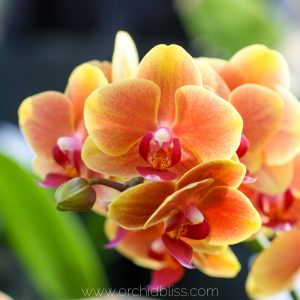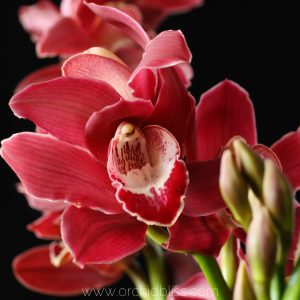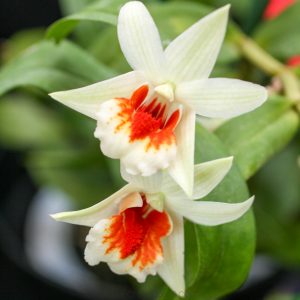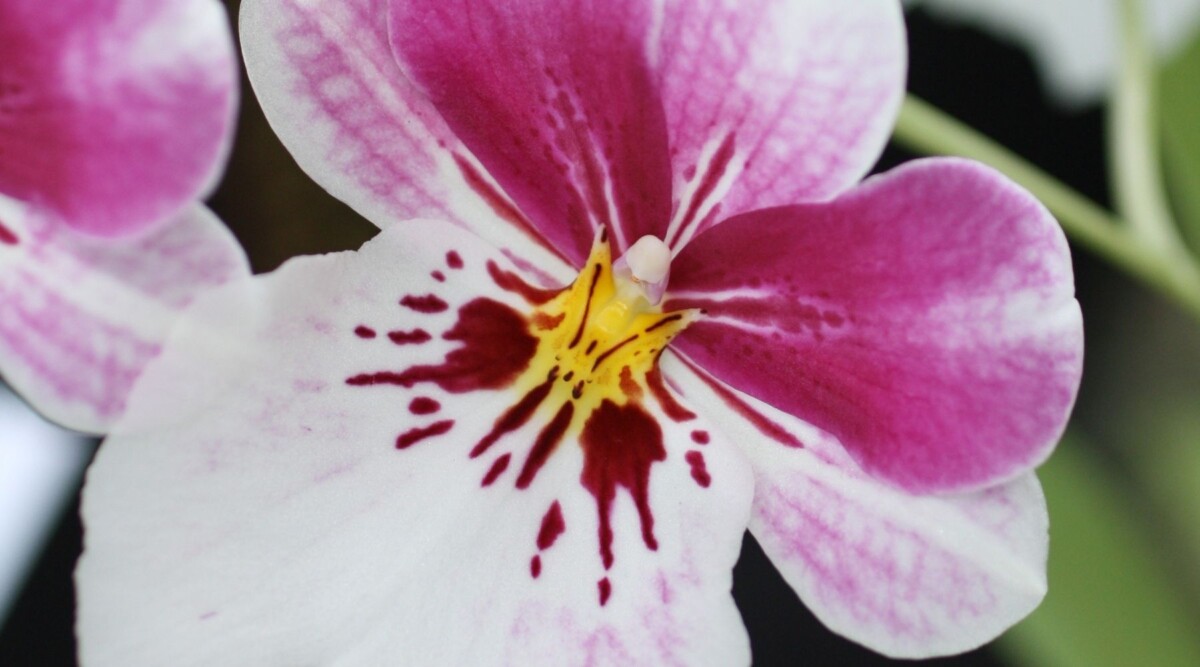
Miltonia Orchid Care: The Complete Guide
Miltonia orchids are a colorful addition to your plant collection. These flowers are delicate and quite particular about the conditions in which they grow.
There are two types of Miltonia orchids: cool-growing and warm-growing. Caring for these flowers involves providing optimal temperatures for each respective type, planting them in well-draining soil, ensuring high humidity in their location, and placing them in bright, indirect light.
Miltonia orchids are considered intermediate-level houseplants as they need specific care and a high level of commitment. However, if you follow this complete guide to caring for a Miltonia orchid, you can care for this picky plant with confidence.
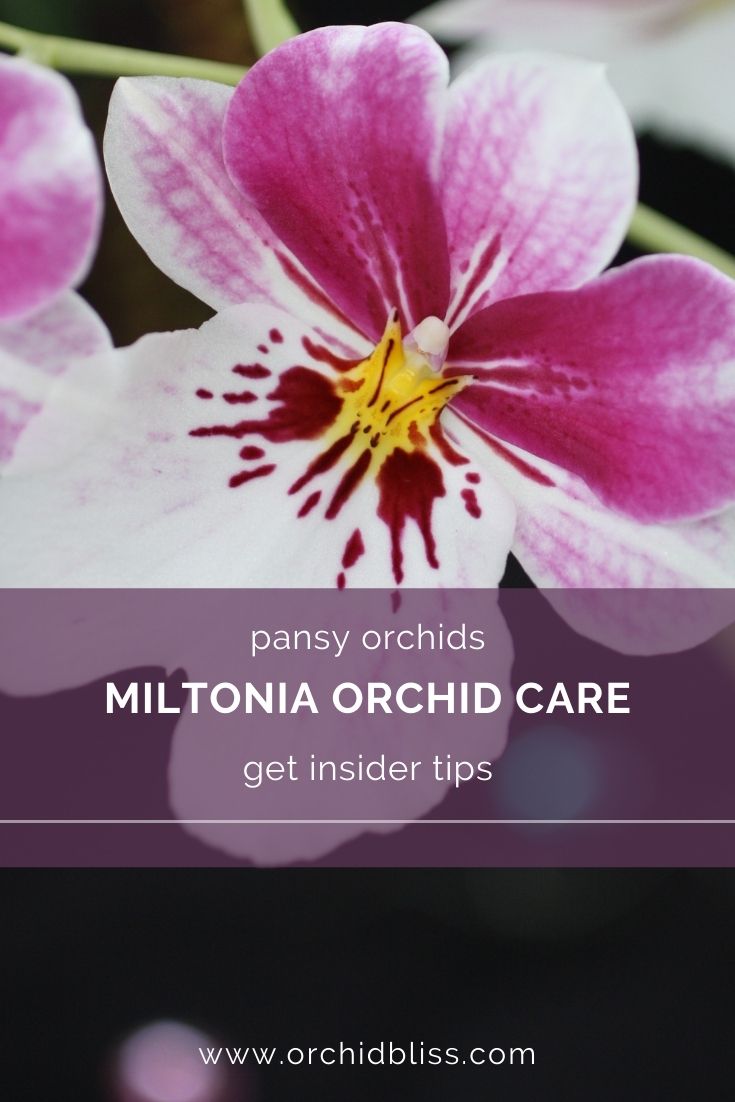
Some of the links on this page may be affiliate links. Click here to learn more.
The Miltonia Orchid
As mentioned, there are two types of Miltonia orchids or two closely related orchids that are generally lumped into the same name. We’ll explain how to care for both of these flowers, which are incredibly similar but have slightly different needs.
The actual Miltonia orchid is a warm-growing flower, generally found in areas of Brazil. The flower we often think of as a Miltonia is actually a Miltoniopsis orchid found in the Andes’ cool mountain regions. These different habitats are what create most of the diverging needs of the two plants.
Fact: The Miltoniopsis orchid was initially included in the Miltonia category, only officially separated in 1976, which the horticulture world is still getting used to.
These flowers are both often referred to as the “pansy orchid,” as the blooming face looks very similar to the pansy. It’s only really the Miltoniopsis orchid that looks like a pansy, though, increasing the confusion between them.
Supplies You’ll Need to Care for Your Miltonia
A visit to your local garden store should supply you with everything you need to properly care for your new orchid. Put the following items on your list:
- Potting mix
- Orchid fertilizer
- Pruning shears
- Plastic spray bottle
- Hydrogen Peroxide
- Light meter (optional)
Miltonia Orchid Basics
All plants have unique needs according to where they naturally grow in the wild. We can learn a lot about caring for a Miltonia orchid by looking at where they flourish in nature.
The Miltonia Orchid (Warm-Growing)
These orchids are almost all found in Brazil, enjoying the warm weather and high humidity of the forests there. Most of these orchids grow between 600 and 900 meters above sea level, where there is less climate variation.
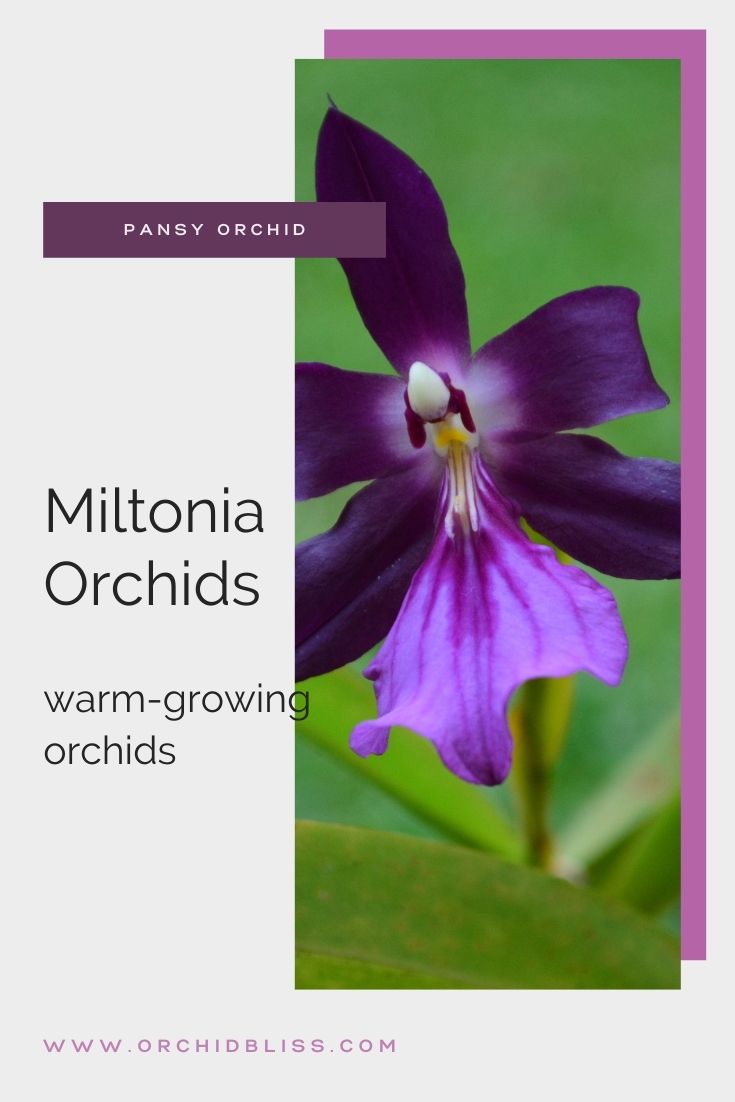
While the Miltonia enjoy a bit more sunlight than the Miltoniopsis’ do, neither enjoy full sun. Miltonia orchids will always be found in the shade, though the area around them can be quite bright.
Miltonia orchids have also adjusted to high humidity. Morning dew and torrential downpours are heaven to a Miltonia, and they enjoy full watering in the summer. These plants are always epiphytes, drawing their nutrients from the air instead of the soil.
The Miltoniopsis Orchid (Cool-Growing)
The proper “pansy orchid,” Miltoniopsis orchids grow at high elevations in Ecuador, Peru, Columbia, and Panama. They are generally found anywhere between 600 and 2000 meters in the chillier mountain climates.
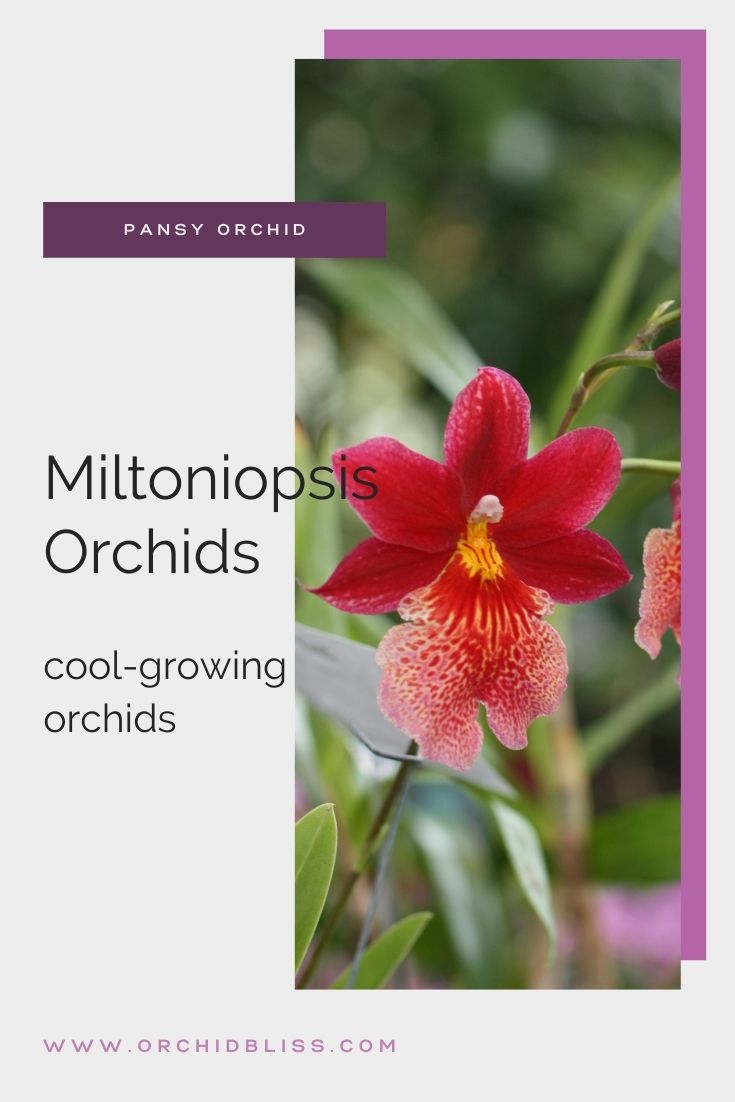
These orchids are highly sensitive to direct sun, with their thin leaves burning quickly from the rays. Shaded areas without direct sunlight are the only places you’ll find Miltoniopsis growing. These plants are heat intolerant and usually won’t flower in temperatures above 80˚F (26.6˚C).
The Miltoniopsis orchids also love high humidity, and they too are epiphytes. Their roots should have access to air and moisture, and they don’t appreciate drying out. An underwatered Miltoniopsis orchid will signify its struggle by including accordion-like folds in new leaves.
Potting Your Miltonia
Both Miltonia and Miltoniopsis orchids should have fine, epiphytic-grade soil. Most common will be a combination of perlite, fir bark, and charcoal, with fir bark making up the majority of the mix. This type of soil allows excellent air permeation while letting moisture move quickly through. Your orchid’s roots will also wind their way through the earth and outwards, searching for nutrients in the air.
The type of pot you use for these plants is crucial as well. A glazed ceramic pot without a drainage hole will mean certain death for your plant. The pot you choose will ideally fit the following criteria:
- Lots of drainage holes
- Lightweight
- Breathable
- Wider than it is deep
The Meshpot Clear Plastic Orchid Pot offers excellent drainage and airflow through the dozens of holes in the plastic siding. The pot also includes an intelligent “air column” that extends into the pot from the bottom. This column serves three purposes:
- Improves air circulation
- Lowers the risk of root rot
- Makes the pot shallower
The best time to repot your orchid is after a successful blooming period. Once the flowers have dropped, the orchid has entered a dormancy phase to regain its strength before going through reproduction (flowering) again. In this dormancy phase, you can safely repot your orchid as it won’t affect the flowers or the roots at this time.
Where to Place Your Miltonia Orchid
Once you’ve potted your orchid, it’s time to decide where it will live in your home. Most orchids enjoy high-humidity areas with lots of light. This place can usually be found in the master bathroom. The humidity from your daily use of the bathroom will be appreciated by the orchid, while the master bathroom usually has plenty of light.
If this isn’t a suitable place for your orchid, then try and match the following guidelines. This step is where using a light meter can come in handy!
Placement of a Miltonia Orchid
A Miltonia orchid loves light but doesn’t love the sun coming in direct contact with its leaves. These plants require about 2,000-foot candles of sunlight to flourish. That amount is considered bright indirect light.
A Miltonia orchid doesn’t need to be directly next to a window, but it should be near one. Watch the shadow move across the room throughout the day, and place your plant just outside this range. This placement will ensure that it is close to the sunlight but won’t be burned.
Placement of a Miltoniopsis Orchid
A Miltoniopsis orchid needs less light than its Miltonia cousin. These cool-weather plants only need about 1,200-foot candles of light, which is still a considerable amount of light. Place these plants in a similar location to that of the Miltonia: near a window but not in the sun’s direct line.
Watering Your Miltonia Orchid
Orchids love to be moist but hate sitting in water. The number one death of a house-bound orchid is root rot. That’s why choosing an aerated pot with well-draining soil is vital for any orchid you bring into your home.
However, your orchid will need to be adequately watered. The Miltonia and Miltoniopsis orchids both need watering about every 7-10 days. In the summer, once a week is typical, even twice a week, on sweltering days. This frequency could drop to as low as once every two weeks in the winter.
In between waterings, orchids enjoy spritzing water from a spray bottle. Focus on the roots when you do this, applying a fine mist on all sides of the container. Many people believe it’s better to spray your orchids in the morning, as it mimics the natural early-hour dew. To avoid bacterial and fungal infections, avoid misting the leaves.
Improper watering often causes a host of problems, resulting in an unhealthy orchid. To avoid these pitfalls, click here to grab your cheat sheet to learn how to grow healthier orchids. It will be super helpful.
Fertilizing Your Miltonia Orchid
All orchids are sensitive to over-fertilization, but epiphytic orchids are even more so. Because their roots are being washed clean with rain so often, they have become susceptible to salts and fertilizer burn.
To help combat the risk of harming your orchid’s roots, you can use an orchid-specific fertilizer that is generally equally balanced in its nutrients. Whichever type of fertilizer you use should be diluted to half-strength. Mix the fertilizer with equal parts water, and apply it to your orchid’s roots biweekly.
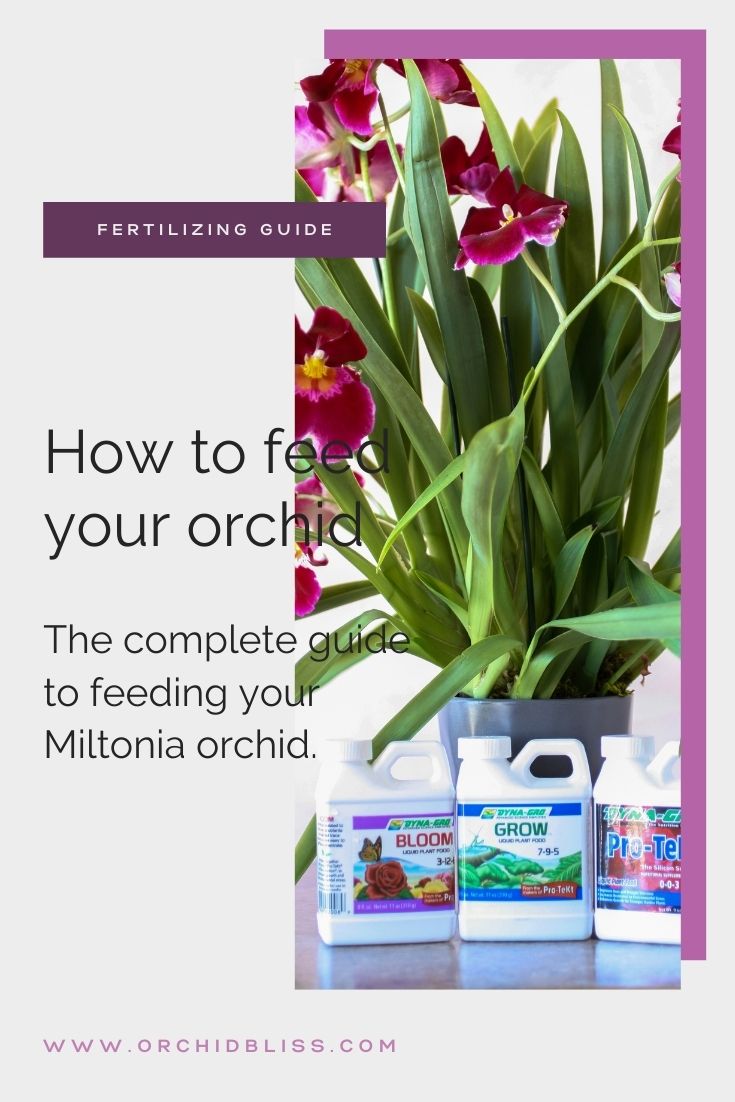
If you’re nervous about causing fertilizer burn, it’s better to err on the side of caution and use too little fertilizer than too much.
Trimming Your Miltonia Orchid
There are times when you should cut back your orchid. For both species, f this stem shrivels or turns brown or yellow, you should cut it off. Using sterilized garden shears, cut the stem directly across at the bottom of the plant. A shriveled branch will not produce any more flowers.
Miltonia Orchid Roots
As noted, both the Miltonia and Miltoniopsis orchids are epiphytes. They tend to develop wandering noodles called “air roots.” These curious appendages reach out from the container of the plant into the air. A mistake of novice orchid owners is to trim these roots, thinking they are cleaning up their plant’s appearance. However, orchids’ air roots are precious and imperative for the plant to pull nutrients from its surroundings.
Most of the time, you won’t need to touch your orchid’s roots at all. If your plant is healthy, you can let their plants wind throughout their container and up into the air. However, if your plant gets sick, you may need to remove some of the rotting roots.
Roots that are unhealthy might appear as the following and will require extraction:
- Black and mushy
- Brown and spotted
- Yellow and brittle
What Not to Do With Your Miltonia Orchid
The following are some things you should avoid at all costs to prevent harming your plant:
- Letting your orchid thoroughly dry out
- Placing your plant in direct sunlight
- Leaving your plant out in temperatures below 50˚F (10˚C)
- Over-fertilize your flower
- Cut your plant’s air roots
Frequently Asked Questions
Now that you know everything you need to take care of a Miltonia orchid (or a Miltoniopsis orchid, for that matter), let’s cover some of the frequently asked questions from new orchid owners.
How Much Do Miltonia Orchids Cost?
Miltonia’s costs more than your average grocery store orchid. Specialty plant stores may carry them, or you may have to make a special request for these flowers. Some nurseries can order them for you, but you should expect to pay between $80-110 per plant.
Where Can I Find Miltonia Orchids?
Miltonia orchids can be found at Trader Joe’s (if you’re lucky) and online on Etsy.
How Long Do Miltonia Orchids Blooms Last?
A pansy orchid’s bloom can last from four weeks up to six if living in perfect conditions.
How Often Do Miltonia Orchids Bloom?
Miltonia orchids usually bloom once a year in the early spring. Some pleased plants can produce a second bloom in the fall. If your orchid isn’t blooming at all, likely, it isn’t getting enough sunlight in its current position. Keep taking care of your plant, and hopefully, it will recover for next year.
How Much Light Do Miltonia Orchids Need?
Miltonia orchids are a plant that prefers bright indirect light. They would be happy near an east or north-facing window where the sunlight isn’t too strong. A south-facing window generally provides too potent sunlight for these delicate flowers.
A Miltoniopsis orchid needs slightly less sunlight but still enjoys medium to bright light. While the light needs of the Miltoniopsis are less, they are generally more challenging to care for.
How Often Should I Water My Miltonia Orchid?
How often you should water your Miltonia or Miltoniopsis orchid will depend on the growing environment and your orchid’s stage in the growth cycle. If your plant is in full bloom (usually in the early spring), it will likely need weekly watering. For Miltoniopsis orchids, if the temperature rises above 80˚F (26˚C), it’s best to increase watering and move your orchid to a colder area.
If your orchid is dormant, you can decrease watering significantly. Once every ten to fourteen days is standard, with light mistings in between. How much water your orchid will use during this time will depend on the location the orchid is in, so be sure to check it every day until you get used to its new drinking schedule.
How Often Should I Repot My Miltonia Orchid?
Miltonia orchids should usually be repotted once a year. This timing has less to do with the actual plant needing more room and more to do with the soil medium’s deterioration.
Since Miltonia and Miltoniopsis orchids are planted in a potting media that often has a high moss content, this moss will likely have lost crucial nutrients and structural integrity that the orchid needs to continue to grow.
Plastic Pots
If you’ve planted your orchid in a plastic pot, getting the orchid out of the pot can be relatively straightforward. Loosen the sides of the container and gently wiggle and pull the orchid out. Snip off any dead or dying roots, and place the orchid in a container 1-2 in (2.54 – 5.08 cm) larger than its last, with fresh soil lining the bottom.
Orchids prefer to have their roots crowded in their pots rather than have them in a large pot with too moil soil. A deep well of the earth will hold more water than the orchid can use and can easily cause root rot.
Wooden Boxes
A trendy container for epiphytic orchids is a slatted wooden box. These boxes have just enough structure to hold the plant’s soil, while the open sides allow for excellent air permeation.
If your orchid is living in a slatted wooden box, like this Sun Bulb Square Cedar Basket, chances are your flower’s roots will grow around the slats. This is perfectly normal and signifies that your plant is flourishing.
When it comes to repotting, you should refrain from breaking any of the roots to remove the plant. Instead, place that planter into a larger wooden basket! Your orchid will continue to grow and will appreciate the extra material to hold onto.
Why Is My Miltonia Wilting?
There are a variety of reasons why your Miltonia or Miltoniopsis orchid could be wilting. The most likely culprit is root rot, which you’ll no doubt be familiar with by now. Root rot is commonly caused by overwatering; the constantly damp soil encourages the growth of harmful bacteria, which in turn kills your plant’s roots, and eventually, the plant itself.
Another reason your Miltonia or Miltoniopsis orchid could be wilting is from extreme heat. Miltoniopsis orchids are developed to live in cool mountain forests, and anything over 80˚F (26˚C) poses a severe risk to your plant’s health. Wilting can be a ready sign that your plant is struggling with the arid climate.
Miltonia orchids, the warmer-growing of the two, can take much higher temperatures than their cousin. The Miltonia can survive upwards of 90˚F (32˚C) as long as humidity remains higher than 75%.
Summary
Miltonia orchids are often confused with Miltoniopsis orchids, which used to be included in the same plant species. Both of these orchids are beautiful; however, the Miltoniopsis is infamously more challenging to grow. Be sure to find out which of these flowers you are purchasing since their care needs differ slightly. Once you are sure of the type of orchid you have, follow this care guide to keep your plant happy and healthy.
Related articles
Orchids and Temperature – A Detailed Guide for Your Orchids
Proper Temperatures - The Under-Rated Tip for Flowering Orchids
ReadSources
- AOS: Miltonia including Miltoniopsis Culture Sheet
- Rare and Exotic Orchids: Their Nature and Cultural Significance
- NYBG: The Magnetic Appeal of Pansy Orchids
- Encyclopedia Britannica: Epiphyte
- Plantophiles: Light Levels for Plant Explained
- American Orchid Society: How Do I Feed My Orchid?
- Gardening Know-How: Miltoniopsis Pansy Orchid
- AOS: Orchid Care

